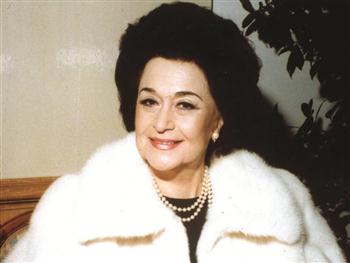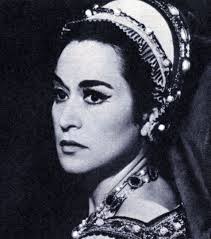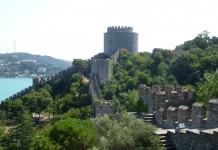 It is said that opera is the ultimate manifestation of art, that it is the pinnacle of artistry: it requires ultimate mastery of music composition as well as the ultimate gift and mastery of the human voice, and these must be combined with a drama performance. Thursday night, the Borusan Istanbul Philharmonic Orchestra (BIFO) was the host of a commemorative evening in honor of one of the greatest, most highly heralded names in the history of opera: La Scala’s Prima Donna, the late-soprano Leyla Gencer.
It is said that opera is the ultimate manifestation of art, that it is the pinnacle of artistry: it requires ultimate mastery of music composition as well as the ultimate gift and mastery of the human voice, and these must be combined with a drama performance. Thursday night, the Borusan Istanbul Philharmonic Orchestra (BIFO) was the host of a commemorative evening in honor of one of the greatest, most highly heralded names in the history of opera: La Scala’s Prima Donna, the late-soprano Leyla Gencer.
Gencer may not have transcended into pop culture like Maria Callas, her contemporary and colleague, or as have tenors Pavarotti or Jose Carreras, her male counter-parts. Regardless, she still has just as much significance for any afficianodo of the opera.
Now, for the opera novice: Born in Turkey to a Turkish father and to a mother of Lithuanian aristocratic descent, Gencer undertook her musical studies in Turkey, and her debut stage experience was in Ankara, in 1952. However, she was soon to rocket her way up to Milan’s La Scala, the most prestigious school and opera house in the world. She was a prima donna there for over two decades (1957-1987) and remained in the institution even in her retirement as the director of La Scala Academy upon the request of the legendary conductor Riccardo Muti. In the opera scene, her name continues to be acknowledged among the greatest of names such as Maria Callas, Renata Tibaldi and Joan Sutherland. When she passed away in 2008, the news made it to newspapers and TV channels across the globe, including BBC, CNN, the Washington Post, and thousands more. Her funeral was attended by the Minister of Culture of Italy, and La Scala issued a statement saying that “they felt honored to be the chosen home of Leyla Gencer.” Michel Parouty, critique of Opera magazine summed her up with the words, “the last diva of our era, a symbol of perfection.”
Thursday evening, on March 20th, BIFO, the Borusan Istanbul Philharmonic Choir, the Children’s Polyphonic Choir of the Istanbul State Symphonic Orchestra, and the magical voices of soprano Maria Jose Siri, tenor Alex Vicens, baritone Eralp Kıyıcı, bass Alper Göçeri, baritone Utku Bayburt, tenor Can Raha Gün, bass Ozan Kutlar, bass Ozan Kutlar, and the acting of İlyas Seçkin came together in an evening in her honor for a performance of the eternal opera Tosca of Giacomo Puccini.
The opera was performed in a unique set up. Instead of the usual location of an orchestra in an opera, BIFO had taken its rightful place on the stage, not beneath it in the orchestra pit. There were no props or stage design except for a small desk, a candle holder, a chair, and two giant images of Roman statues on either side of the stage. Behind the orchestra was a huge white screen that depicted scenes related to Tosca as the story began to unfold . It began off in the La Chiesa di (Church of) Sant’Andrea della Valle in Rome, the opening scene of Tosca. In the second act, Baron Scarpia, the antagonist, and Tosca, the benevolent heroine, acted out and sang their parts with the Orchestra behind them, and real images of Palazzo Farnese behind them. The screen also featured recordings from actual performances. As Cavarodossi, the ill-fated benevolent hero and Tosca’s lover, fell victim to Scarpia’s malicious trick and collapsed with the shot of bullets on stage, so did the Cavarodossi depicted simultaneously in the screen behind him.
I will not attempt to describe or comment on the eternal masterpiece of Puccini, or on the cast’s impressive mastery of the art form. My only note will be to share my thought that just like certain scenes make a movie, certain lines make a book or certain stanzas make a poem; there exist certain arias, selections, or scenes in an opera that have become to define the opera of their origin. The aria “Brindisi” in Verdi’s La Traviata. The “March of the Toreadors” and the subsequent aria “L’amour est un Oiseau Rebelle” (Love is a Rebellious Bird) in Bizet’s Carmen. In Puccini’s Tosca, the two arias “Visi d’Arte” (I have lived for art) and “E Lucevan le stelle” (and shining were the stars) were the highlight, the most memorable scenes and arias of the evening. Maria Jose Siri’s “Visi d’arte” touched our hearts as we also felt all the emotions of Floria Tosca, the benevolent heroine who had lived her life for art (“visi d’arte”), for goodness, for prayers, and good deeds, but who still could not escape her ill fate. And as tenor Alex Vicens requested as Cavaradossi from the guardian Carciere to jot down his final wish beginning with the line “E lucevan le stelle, ed olevazzava la terra ….” we all held our breaths and were drifted to worlds of musical and vocal beauty unparalleled.
Like many an opera, Tosca has a tragic end, but the evening was no tragedy – it was a celebration of the life and legacy of one of the greatest divas of opera, of Leyla Gencer, and a celebration of the ultimate manifestation of art, performed by impressive talents.











[…] The increasing temperature is not the only signal that summer is just around the corner. One by one, the concert halls are wrapping up their seasons and closing the curtain until fall 2015. The Istanbul Borusan Philharmonic Orchestra — more popularly known as BIFO among the locals and BIPO among expats — also marked the end of the year with its annual closing performance dedicated to the late and legendary soprano Leyla Gencer. […]